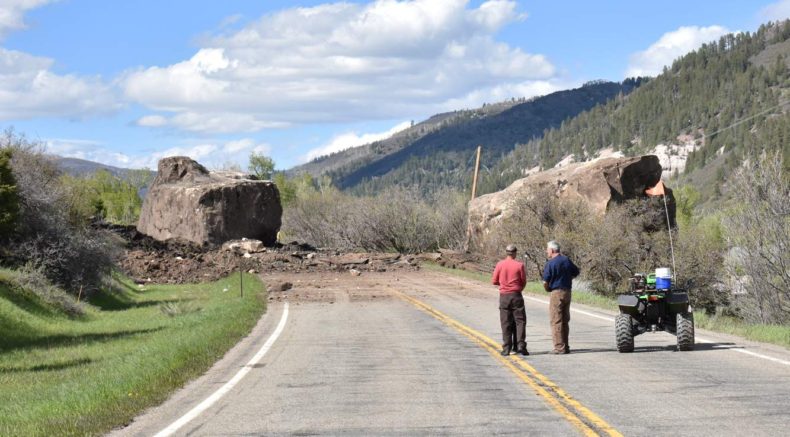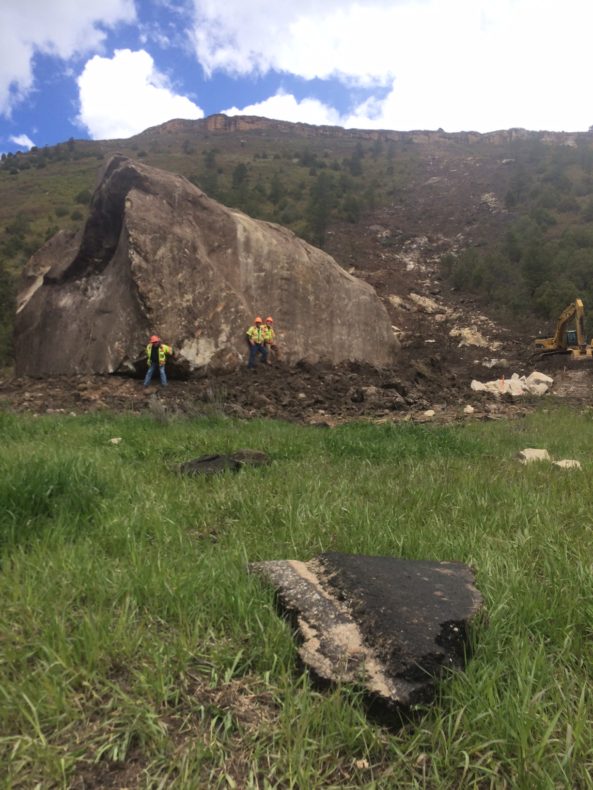
Earlier this month, a pinpoint landslide let loose onto a highway near where I live in southwest Colorado. No homes were destroyed. No cars were crushed, though three were narrowly missed. One pickup punched into reverse, its body hammered with rocks, occupants safe.
What is significant is the tonnage of two boulders that tumbled a thousand feet and planted themselves across Highway 145 between the mountain town of Telluride and the desert town of Cortez. Both are squarish blocks of Dakota sandstone, one estimated at 2.3 million pounds, the other at 8.5 million pounds, leaving a trough eight feet deep in the asphalt. I imagine the view from that pickup the moment it happened, two rocks the size of houses, a one-bedroom and a three-bedroom, landing out of nowhere, like Godzilla crashing into the frame.
I like the way earth falls apart, a fan of geomorphology. I’ve pushed off a few big blocks myself, charmed by the way they were caught on a corner while falling and just needed a shove from a boot to keep their journey going. Out in the middle of nowhere, I felt like the rocks wanted to go. That’s my excuse, at least. When I skip rocks across a river, I sometimes think the rock desires its baseline, its angle of repose, every skip sending it to its lower, granular resting place.
These two weren’t so much in the middle of nowhere, rather the middle of the highway. There aren’t many paved thoroughfares in southwest Colorado, few enough that one going down has a significant impact. This is the only way south out of Telluride, and the boulders fell during a film festival so that many leaving Telluride at the end of the holiday weekend had to re-route by a couple of hours. We’re used to rockslides, waiting behind clearing crews, or weaving through chunks the sizes of barrels and engine blocks freshly fallen. It’s geologically active country, but this is a unique scale.
A friend working at the rockslide for the Colorado Department of Transportation said they wanted to put a sign on the biggest, noble-looking boulder reading “Heading for the Gulf,” referring to the eventual end of the Colorado River watershed at the Gulf of California, destination for all these boulders and grains of sand. He started sending me photos, including the one below, commenting, “Hell of a gravity storm!”

The 2.3 million-pounder was blasted to pieces and moved out of the way. The larger was left as is. Named “Memorial Rock” for its arrival on Memorial Day weekend, it was spared demolition. The highway is now being widened to go around it. The governor said widening the highway would cost $200,000 less than blowing up the thing and taking it out piece by piece. It was turned into a monument.
Glacial erratics sitting in farm fields, crop rows separating like a river around mounds. Buildings constructed around standing trees. Context is kept. We don’t take out everything. Sometimes we part ourselves, the architecture of respect, even if incidental.
I think of sentimental reasons for not blowing up this rock. It clearly wants to stay where it landed. After about a hundred million years of being cemented into Earth’s stratigraphy, it finally broke free. I can practically hear the yips and hollers of excitement as it split from the rest of the Dakota Sandstone caprock it belonged to and made a run for the Dolores River far below. I know it’s only rock, said to not be sentient (though sedimentary), not a thought or a wish in its nonexistent head. Leaving it in place may only be about us, creating an attraction on the side of a newly paved highway. I can go with that. Even if it cost more, I like to think we’d still leave it there.
Top photo: Durango Herald
Lower photo: Larry Ruiz
We, here in the Upper Arkansas River Valley, have our own rockslides to occasionally deal with—the overwhelming majority being merely slight nuisances. We had our own memorable one, about eight(?) years ago, which caused folks to have to drive roughly two hours out of their way in order to make it to the other side of the week-and-a-half long, 130 ft wide, 8 – 10 ft high rock pile. (We’d had a wet spring with back-and-forth freezing/warming temps.) No one, no cars hurt here, either; albeit the last car through saw the slide in their rearview.
However, I doubt the entirety of that slide weighed two-point-eight million pounds, never mind eight-point-five million.
It seems odd that two ginormous boulders fell at the same time. Did the larger boulder knock the other one loose on its way to 145? Will CDOT eventually turn the area into a Point of Interest rest stop, complete with explanatory plaque and picnic tables? Also, have other smaller rockfalls occurred, since?
“And, hey—let’s be careful out there.”
Boulders. the size of houses always have the right-of-way in my world
Physicists describe the desires of rocks in just that way. I’m linking to this because it’s everything I know about the subject, which ain’t much so it’s short: https://www.lastwordonnothing.com/2010/10/07/science-metaphors-cont-2/
It smushed a seed pot to dust on the way down.